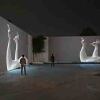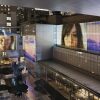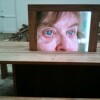Doug Aitken's Migration
"Beaver! Beaver! Beaver!" shouted a rowdy group of tourists in a Starline doubledecker cruising Santa Monica Boulevard last night. They were cheerfully heckling the crowd gathered outside the Regen Projects II gallery in West Hollywood watching Doug Aitken's dual projection of a 24-minute video titled Migration, which features luscious close-ups of a bevy of wild animals - including a beaver - all of whom are uncomfortably poking around various roadside motel rooms, pawing at the ugly carpets, romping in the scratchy bedding and, in the case of the beaver, enjoying a bath. "Video installation can be this workshop where ideas can collide and combine and be released again," Aitken said to me in an interview a few years ago. "And I think that's what I'm always striving to do - to use these opportunities to engage a series of challenges and questions." But what are those challenges and questions now with this new project?
Aitken, who was born in Redondo Beach in 1968 and attended Art Center College of Design in the late '80s, began his career shooting photographs, and then turned to video installation in the early 1990s. His previous work has explored the unfolding of time, the disruption of spaces, the role of the physical body and notions of being, and he has typically used video installation - with multiple screens inviting new ways of experiencing a story - as a way to explore these ideas. You could say he spatializes time, and temporalizes space; he returns to the origins of cinema and its frame-by-frame march through temporality but he juxtaposes that breakdown with the seamless ebb and flow of video; then he asks us to ponder these two versions of time by meandering around a series of screens in darkened spaces, gleaning fragments of story and character through our own experience of fragmentation and reconstruction.
Some examples: Aitken's Sleepwalkers is what the artist dubs a "broken screen" narrative in a book he wrote of the same title; it consisted of gigantic projections onto six facades of New York's Museum of Modern Art in January and February of 2007. The silent story, told in exquisite imagery, chronicled the lives of five characters as they moved through the city. Visitors strolled around the block to see the silent film's 11-minute segments and the large images, with many of them close-ups that exacerbated the sense of enormity of the faces and figures of the characters, were visible from blocks away from the museum. In essence, the characters became the city, and the project offered a provocative consideration of city as a space of multiple, mutable information flows.
In his 2005 project titled A Moment, Aitken united a series of vaguely linked moments across 11 screens suspended from the ceiling of the Regen Projects gallery space. They were positioned at eye level and in a gently curving S-pattern, with mirrors on the backs of each screen. The video footage showed images of people sleeping and then waking, and these shots then drifted into those of empty parking lots and the arching lines of telephone wires stretched across the sky. Anonymous grids of mirrored skyscraper windows and empty bedrooms were intercut with close-ups of eyes, skin and torsos. All in all, the project suggested liminal, refracted moments, places hovering between other places, and a shared psychic vulnerability.
With the video installation Blow Debris Aitken similarly played with storytelling with a narrative of sorts, but once again fractured the story with multiple projections and spaces. Viewers followed a group of nude wanderers in a desert landscape littered with detritus - rusting shopping carts, smashed televisions, gutted cars. The characters meandered about, and you could almost feel the dusty sand and the dry wind, as well as the erasure of a grounded sense of time and space. And then things exploded, time reversed, and Aitken achieved a kind of psychic vertigo; watching the reversal, you felt compelled to walk around some more, back and forth through rooms of temporal and spatial dislocation and relocation.
Finally, with electric earth, which won the International Prize at the Venice Biennale in 1999, Aitken staged a loose, 9-minute narrative across eight screens; viewers followed a single character who leaves his bedroom to wander through an empty urban landscape at night. He responds to the city's invisible pulse - the electric earth - through his body, which shakes and undulates. In turn, we wander through the installation's numerous screens, glimpsing a detail here, a gesture there. There is a story, in the sense of a linear progression of events. However, our experience is far more ambient, with repetition and variation replacing the rising action and forward thrust of traditional narrative.
Reflecting on these earlier projects, then, it's clear that Aitken's latest project is less centered on the multiplication of screens and the possibilities of nonlinear narrative of his earlier work, and instead settles down to consider the relationship between the natural and cultural as they meet both within the video and on the street where it's projected. With the outdoor projection at Regen II, the shadows of viewers merge with the images on the exterior walls, and it's impossible not to ponder our connection. Aitken zooms in on the animals - the soft feathers, luscious fur, delicate rabbit ears - and spectators frequently sighed audibly in response to beauty and cuteness. But the video is not about sentimentality as much as the juxtaposition of unlikely things designed to prompt thought.
the details:
outdoor projection, sunset - sunrise: Regen Projects II
9016 Santa Monica Boulevard
indoor projection with soundtrack
Regen Projects
633 North Almont
Through October 17, 2009






